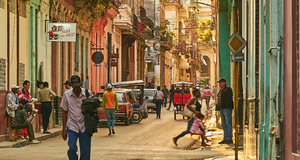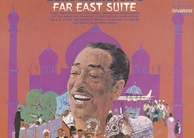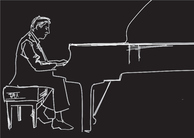The Origins of Cuban Music and its Cultural and Spiritual Importance Within the Cuban Diaspora Community
By
2015, Vol. 7 No. 10 | pg. 1/2 | »
IN THIS ARTICLE
KEYWORDS
This paper explores how the Cuban Diaspora has formed connections and forged a new identity around music, meanwhile reinforcing the resiliency, adaptability, creativity and autonomy of the Cuban people in the midst of crisis and uncertainty. Arts and culture are not just forms of entertainment, but messengers and affirmations of culture and spirituality. These are all manifestations of a collective identity, which becomes personal. Popular music acts as a conduit that people filter their own experiences through. Throughout Cuban history, patterns of travel and emigration have molded the identity of the people and defined generations (Gleason 113). The origins of salsa and its predecessor, son cubano, of which little is known, are also discussed. The Afro-Cuban son is rich with religious rituals and sensual dances, and there is a rich history behind its rhythm. My objective is to show the psychosocial importance of this genre as it helped to shape and preserve the sense of culture and identity that were stripped from the African diaspora that landed in the Caribbean as slaves. I explore the son cubano and its offspring, salsa, as more than a popular genre of Latin dance music, but as an agent of cultural preservation emblematic of the Afro-Caribbean religion Santería (“the way of the saints” in English). Salsa music has its roots in the Afro-Cuban genre son cubano. The sundry rhythms of salsa can be adapted to any mood, for it can be romantic and soft, spiritual and reflective, fierce and passionate, melancholic and gloomy, or simply happy and energetic. There is usually a subliminal message embedded within each song. Underneath the layers of percussive horns and fast-paced, exotic rhythms there is usually a story that unveils the realities of the social struggles in the Hispanic community. These songs also reveal a fierce determination to cultural roots and traditional values. Salsa embodies the essence of Spanish speaking Afro-Caribbean culture, religion and history (Gleason; 113 Mancuso 28).Historical and Ancestral OriginsSon music has roots in Yoruban sacred music which originates from Nigeria. African based religions arrived in Cuba around the late 1500s during the inception of slavery (Hodges 35; Leymarie 10). Its folkloric tradition is surrounded by mysterious rituals, burnt offerings and animal sacrifices to the Gods. In those days, Afro-Cuban slaves circumvented Catholicism, the new religion imposed upon them, by melding with their own to give the appearance of having assimilated Catholicism (Díaz; Hodges 18-19; Leymarie 12). The slaves did not relinquish their culture; they substituted the names of their African gods with the names of the Catholic saints. For example, Obatalá became the Creator, God Himself as monotheistic religions describe this all-encompassing spiritual guiding force. Their god of war Changó was renamed Santa Bárbara or Saint Barbara. Yemayá, the sea goddess became the Virgin of Regla, an outlying suburb of Havana. Their native prayers were translated from Yoruba to Spanish; which later evolved into a liturgical language called Lucumí, a Cuban dialect of Yoruba. This linguistic evolution was the birth of creolized Spanish in Cuba. Regla de ocha, another name for Santería, is an animist religion that combines Yoruban (e.g. Nigerian) rituals with Catholic ones. Regla de ocha means the rule of ocha. This forms the basis for the worship of the orishas or African gods. Santería faith is unique because it is truly a creation of the Americas. Santeros or shaman priests in Cuba speak Lucumí to this day. The slaves were so successful in their dissimulation of the Catholicism faith into their own that even some slave owners unwittingly participated in their slaves’ Santería rituals believing it to be a black form of entertainment. They were enchanted by the intoxicating sound of the drums, as female slaves performed intensely erotic movements during fertility ceremonies. Indeed, Santería music and dance is so beautifully hypnotic, it is easy to get lost in ecstasy, and fall into a trance (Concha-Holmes; Díaz; Gutiérrez 308; Gleason 114; Leymarie 10-13; Mancuso 28-29). There are parallels between music, spirituality, food and sexuality in Hispanic musical forms. Music in Cuba does not just feed the soul and mind; but the senses as well. This explains the erotic and sensuous connotations to it. The five senses form part of a greater whole rather than compartments to be indulged in at different times; like clockwork that must be scheduled (Leymarie 4-5). Sandunga means elegance and grace in Spanish. Cuban musicologist Fernando Ortiz described the Africanized word as salt and pepper. The salt being from Andalusia (white) and the ndungu pepper (black) being from Africa. Just to clarify, Andalusia is a province in Southern Spain close to Morocco and Algeria with a strong Moorish influence. That province is where the majority of Hispanics of European descent came from. This mixture reminds me of the traditional Cuban dish of moros y cristianos or Moors and Christians. The savory and aromatic dish is rice cooked in black beans, which is not the same as white rice and black beans. Moros y cristianos looks like a perfectly blended rice and bean dish because it is monochromatic. From a culinary standpoint, this is representative of the all of blends that took place across cultures. Cuba’s music combines the African languages (e.g. Abakwa, Yoruba and Congo among others) with Spanish. Very little exists of Cuba’s indigenous roots; except for güiros and the maracas (Díaz; Leymarie 9-17). The Yoruban people, or Lucumí as named in Cuba, helped to establish present-day Cuban culture on the island. Before the Cuban diaspora could take their music and culture abroad, African slaves were the first group of people who saw themselves in the situation to take their culture wherever they were sent. They replicated the African musical instruments that they were forced to leave behind. They incorporated European instruments such as mandolins, guitars, tubas and ophicleide (in the brass family) among others into their repertoire. The African diaspora traveled through other mediums outside of the continent as evidence by the strong cultural influence in the Spanish Caribbean, e.g. Cuba, Puerto Rico, Dominican Republic, Panama, Colombia Venezuela and others (Leymarie 10). The Bantu people were also known as the Congos in Cuba. These people assimilated themselves more quickly into white society than other African tribes. As a result, their religious traditions watered down somewhat as the collective Cuban identity emerged. “Conga” means song and tumult in Bantu. Mambo means prayer, a conversation with gods and sacred dance; and “mamba” means water goddess in the Congo language. Congo songs are full of satire, piques and disparates or nonsense in English. Some Congo prayers incorporated the Arabic salute salaamu aleikum, which in Cuban Spanish became salamaleco. The Araras, another African tribe, descended from the Fon people of the Dahomey kingdom or present-day Benin. Araras descendants can be found in the cities of Matanzas and Jovellanos, which are roughly two hours east of Havana. The remnants of their culture and religion were absorbed into the Yoruba tradition and pantheon. The Abakwa (e.g. Carabalí or more informally, ñáñigos in Cuba) hail from the coast of Calabar in southeastern Nigeria and comprise of people from Ibo, Ibibio Ejagham and other tribes. During the nineteenth century all of these tribes formed secret societies in Havana, Matanzas and Cárdenas. The cabildo evolved and took on a life of its own and a few still exist in Matanzas to this day (Concha-Holmes 490; Leymarie 15-17). During the seventeenth century, free blacks in the outskirts of the cities resisted colonial leaders and created their own town councils or cabildos. These councils comprised of different African ethnic groups. The meetings were an organized affair and operated much like a club where people worshipped, played music, assisted each other, engaged in activities of recreation and eventually organized resistance movements. Colonial interference came in ebbs and flows as it was on a case by case basis. Some political leaders tolerated the cabildos presence as a form of entertainment during carnivals as part of a comparsa or singing and dancing group; while at other times they were banned. Despite these uncertainties, Afro-Cubans persisted, even if that meant going underground. It can be speculated that in these secret meetings where the early sounds of son were born. Afro-Cuban culture continued to proliferate during slavery; and in 1831 there were three times as many black musicians as there were white (Concha-Homles 490-492; Gleason 113; Leymarie 10-11, 19). The African tribes’ religious music later evolved into secular music in Cuba. The blending of the sacred with the profane is nothing new in Cuba. This bonding and sacred ritual in religion became part of the social contract for the nation forming its identity. The central theme of the thesis will be the son cubano, the backbone of salsa and Cuba’s heart according to Ibrahim Ferrer. Cubans took their religion, culture, musical traditions and souls with them when they emigrated the island in the 1960’s. They collaborated with the people of the country that now lived in be it the United States, Spain, Puerto Rico, Venezuela and created a cultural hybrid. This combination helped to create new musical forms such as salsa or bring another dimension to diverse musical genres such as Latin and American pop, jazz, disco and rhythm and blues (Leymarie 31, 208, 231). The Merging of the American Gulf Coast with CubaNew Orleans and Cuba have a virtually identical multiethnic background that consists of African, Italian, French, Native American and Spanish heritage. Both places lie on the edges of the Gulf of Mexico and the Caribbean Sea. But the Gulf connects and disconnects these cultures not unlike the Mediterranean Sea which acts as its own unofficial “cultural confederation.” South Louisiana, Cuba, Mexico (e.g. the states of Veracruz and Tamaulipas), and other countries in this region share similar though not identical cultural elements. New Orleans is the first major city on the southern tip of the Mississippi River, which acts as a cultural launching pad in the United States. Similarly, Cuba is in the middle of the Caribbean Sea that connects with greater Latin America. The island nation has created many genres of music that have reverberated across the Hispanic Americas. New Orleans and Havana are only 694 miles apart from each other (Stewart 1). Prior to the embargo, the cities of Havana and New Orleans were along twin trade routes crisscrossing the Gulf of Mexico. Goods not only traveled but so did people. This exchange enabled a broad cultural exchange between the metropolises. New Orleans and Havana were widely regarded at the turn of the nineteenth century as a prime tourist destination for entertainment. In 1809, nine thousand Cuban immigrants arrived in New Orleans. Of these first wave refugees, about a third were white (mostly of French descent), another third were free persons of color (usually ethnically mixed French Creoles) and the other third were slaves. These people were émigrés from the French colony of Saint Domingue which later became Haiti (Stewart 1-2). The Saint Domingues first appealed for refuge in Cuba in 1803 due to the Haitian Slave Uprising which spanned from 1791 to 1804. Their six-year stay in Cuba was marked with tensions and suspicion. Marquis de Somerueles, Captain General of Cuba, commanded that all of the “Frenchmen” or negros franceses be exiled as their presence may be a threat to the island. According to Stewart, “Frenchmen” comprised of anybody who originated from Saint Domingue (e.g. modern day Haiti) regardless of their social status or race. The remaining Haitians that did not set for Louisiana mainly settled in the eastern Cuban province of Oriente. They established their own recreational socities called tumbas francesas French paths. Some Haitian-Cuban communities practice vodú or voodoo with musical instruments found in Haiti to this day (Leymarie 18; Stewart 1-2). The Saint Domingue immigrants made New Orleans their new permanent home. New Orleans suffered from a dearth of musicians in 1810. By 1811 the musical crisis improved a little, which suggests that “some of the refugees were musicians.” The ingenuity, adaptability and strength of Afro-Caribbeans cannot be underestimated. They found the way to turn the worst of circumstances into a new and beautiful sound (Stewart 1-2). Afro-Cuban jazz musicians at the turn of the twentieth century collaborated with New Orleans jazz musicians. Culturally, two creolized communities in the Americas banded forces to enhance each other’s repertoire. In turn, the two societies reshaped their own ethnic identities on their own terms. Despite the fact that there are Cubans dispersed across the world, their music acts as an umbilical cord which gives their life sustenance, meaning and a sense of familiarity (Stewart 1, 8). Regardless of one’s spiritual affiliation or lack thereof, there are moments in a person’s life in which there are invisible and subtle forces at play that support one in this journey that is called life. That is the power of music at its best. Cuba and New Orleans maintained their relationship from the 1930’s to the early 1960’s. Cuban entertainers traveled to New Orleans regularly and appeared “at both black and white music venues.” Wealthy Creole businessmen took frequent vacations to Cuba where racial divisions were less restrictive than the United States. Cuba’s color structure is reminiscent of French Louisiana or present-day southern Louisiana where racial boundaries were often blurry; and one’s family lineage and cultural background were of great importance. After the triumph of the Revolution, some Cubans with a New Orleans tie relocated there (Stewart 8). A New Ethnic and Racial IdentityAccording to Assata Shakur, “El que no tiene de Congo tiene de Carabalí” (Leymarie 10; Safa 88). In English this means: If one does not have Congo in them, they have Carabalí. In other words, Cuba’s African presence is undeniable regardless of one’s actual ancestry. The ideal Cuban is mulatto or of mixed race. They embody the island’s African and European heritage. These mixed roots became Cuba’s national symbol. It embodied an image of true racial harmony irrespective of the nation’s complex and turbulent racial politics (Benítez-Rojo 179-180). Although racial mixing in the Caribbean was encouraged, sometimes it became an act of necessity or survival. Most if not all of the colonizers were male and their families remained in Europe until the coast was clear to settle in the Americas. In the interim, some European men had relationships with indigenous and African slave women that produced offspring. This notion of national and ethnic identity runs parallel “with the negative view of race mixture in the United States” and enforced ethnic diversity (Díaz; Hodges 29, 33-34; Safa 89). Despite the strong African roots that Cuba has, racism still exists. It is a contradiction that black religion, culture and music are revered, yet nobody wants to be moreno or negro, black in Spanish. These beliefs are rooted in colonialism and slavery where the madre patria or motherland is held in high esteem. Spain is universally seen in mainstream Latin America as the madre patria. For a sizeable group that place would be West Africa; while the remaining people of indigenous origin are already home. This is not counting the people of Jewish, Chinese, Filipino, Arabic and other non-Spanish European ancestry who settled into the Spanish Caribbean (Díaz). Though Cuba and the Spanish Caribbean have a strong black presence, there are not many artists of color are represented in the mainstream Latin music market. The few artists of color that are represented remain the same, indicating a lack of diversity. The only reason that the socialist regime did not completely outlaw African based religions (e.g. Santería) was because they did not perceive it as a threat to the establishment. On the surface, it seems that there is acceptance for diversity, but it is more of an act of convenience and a way to appease the people in a society where religion was outlawed after Castro’s presidency. Afro-Cuban religion does not interfere with politics as it is not an organized religion. Thus, the Cuban people still had a spiritual life in spite of the new restrictions (Díaz; Sigler). The Politics Behind Cuban MusicPolitics and music are tightly interwoven throughout Cuban history. There were laws in the books that were religiously based and thus formed a collective morality which citizens had to abide by. Article 26 of the 1910 Cuban constitution stated that one was free to proclaim any religion as a form of worship without any respects so long as Christian moral values and public decorum were respected. The language of this article gave the government carte blanche to interpret and define what was “considered respectful, regarding Christian morals and the public order.” The article embodied a contradiction with respects to son due to its connotations with animist African religions, far from the European Judeo-Christian model. African religions were the blueprint for secular Cuban music. Due to this backhanded language, the government could interfere in nonwhite cultural manifestations on the premise that they encouraged immorality. Although the majority of the opposition to son was the white Cuban elite, there was a sizeable black middle class that supported the censorship of son (Chambers 504). The most vociferous group was the Afro-Cuban association named Club Atenas. This exclusive association had leading members of the black intelligentsia such as prominent Cuban sociologist Gustavo Urrutia, whom promoted the advancement and incorporation of Cubans of color in all branches of society. According to Alejandro de la Fuente many of the presidents of Club Atenas “were members of Congress or held important government offices at the national level or both between the creation of the club in 1917 and the end of the republic.” The actions of the Club Atenas body were contrary as they rejected their African roots and assimilated European culture. Club Atenas viewed itself as promoting more prosocial behaviors in the Afro Cuban community. However, many leading members were politicians in close association with white Congress members. Thus, they were sorely out of touch with the average Afro-Cuban José or Josefina (Chambers 504). From 1928 to 1933 Cuba’s leaders periodically banned playing son in public. “African” instruments were less tolerated than the “European” ones. Minister Rogelio Zayas Bazán banned movies, tried to shut down dance academies, and even fined men who flirted with women in public. In 1929, Gerardo Machado, the mayor of Santiago, prohibited congas and bongos. African musical instruments were treated like weapons of mass destruction not unlike the days of slavery. Cuba’s conservative movement restricted sexuality and creative expression. Music was a racialized affair during Cuba’s segregation era. The Europeans continued to manifest the attitude that the former black slaves as the other. Integration was impossible (Leymarie 44-45). History as a tool for creating a new national identity was pivotal to the success of the Revolution as it symbolized a symbiosis of the island’s new and future collective experiences. This discipline was not treated like a spectator sport. It became an object used to impulse and mobilize citizens into action and feel a renewed pride in their heritage and culture. Castro rallied Afro-Cubans behind his Revolution and refashioned the island nation as an Afro-Latin nation or an appendage of Mother Africa. This replaced the traditional notion of the motherland, at least for Cubans on the island. However, many Cubans in the United States still maintained that Spain was the madre patria. Interestingly enough, Fidel Castro is of Galician descent in northwestern Spain. The concept and irony of sandunga is not lost here (Díaz; Domínguez 8). In the beginning of the Cuban Revolution, a vigorous censorship campaign was launched aimed at silencing two of the oldest and most intrinsically rooted religions in the island of Cuba: Santería and Catholicism. That was a tall order considering that the Spanish colonialists tried to erase Santería from the psyche of the African slaves that were shipped to Cuba in the 1500s with negative results. Despite the hostile political climate and harsh prohibitions, Afro-Cuban music could not be silenced (Díaz; Hodges). Somewhere along the way, Castro had a change of heart. The reasons for this change are complex and are rooted in politics as much as personal values. It is suggested that El Comandante himself turned to the Yoruban faith as a means to find healing and protection from enemies (Boadle; González 264; Harvey; Sigler). His 1980 trip to Africa appeared to be a turning to point for him. He wore all white during his visit and was surrounded by Santeros. This is the color that Santería adherents use for their priests and their apprentices (González 261-266). Santería is a religion based on peace and palliative treatments (Sigler). Remarkably, Afro-Cubans managed to outwit Castro’s sanctions on the practice of this religion and its associated music in Cuba. When one observes the parallels with colonial history to modern history, there are similarities in the way Afro-Cubans circumvented Spanish imposed Catholicism then and now. This time, they left out the Roman Catholic influence of Santería. The Santeros did this because the regime viewed most organized religions as a threat. Santería is not an officially recognized religion around the world. This proved to the communists that their rituals were not a menace to the system; and thus they were able to evade censorship and possible incarceration. Since the government imposed great roadblocks to organized religion such as increased surveillance and harassment; Santería became a safer alternative to worship and have a sense of community in a new society that left many feeling disoriented (Díaz; Leymarie; Sigler). One could argue that this is what the gods may have wanted for Cuba because the Santeros had to revert back to a more pure form of Afro-Cuban Santería (Boadle). They incorporated more religious music into their rituals, which spread throughout the island like wildfire. During this renaissance phase of Santería, the government became more lax in enforcing the ban (Harvey). This seemed to appease the Cuban people. It also gave rise to a revival of the Yourba-Lucumí culture with a Cuban twist. In many ways, this proved to be beneficial to Castro’s government because Cuba has excellent diplomatic and cultural relations with all African nations (Díaz). As times changed and Cuban musicians arrived in the United States, the son cubano evolved into what today is known as salsa. Unlike any other genre of music, a paradoxical bond exists between Cuban son, Catholicism and socialism. This strange relationship has enabled it to endure the religious and political censorship in Cuba as it had done centuries before during slavery. The music and rituals have survived in spite of the socialist ideology and censorship of the last century (Sigler). Beneath the surface of its intoxicating cadence and spiritual notes, the political and elements that hide beneath this art form transcends past and present folklore and culture around the world. Few musical genres have been able to achieve this seamlessly (Díaz).Continued on Next Page » Suggested Reading from Inquiries Journal
Inquiries Journal provides undergraduate and graduate students around the world a platform for the wide dissemination of academic work over a range of core disciplines. Representing the work of students from hundreds of institutions around the globe, Inquiries Journal's large database of academic articles is completely free. Learn more | Blog | Submit Latest in Music |


















